Bukayo Saka was one of very few Premier League attackers to play every minute over the festive period, and there is no sign of his manager giving him a rest. But is it time for the Arsenal star to get a break?.
It’s October 2022. Arsenal are top of the Premier League, four points clear of Manchester City. Realistic Arsenal fans don’t genuinely believe their team is going to win the title, but they are still enjoying the start to the season their team has made. There are reasonable concerns, though, that any injury to a key player in what is a lightweight squad could derail their season before it has got started.
So, when Bukayo Saka fell to the turf in pain following a rough challenge during Arsenal’s Europa League tie with PSV Eindhoven, there was understandable worry. With the hosts already 1-0 up with just 15 minutes remaining and only needing a point to guarantee their place in the knockout rounds after four group-stage games, many of the home fans would have wanted Saka to be withdrawn. Most probably assumed he would be.
He played on for another 10 minutes, though, before eventually being withdrawn on 85 minutes. Saka hobbled off the pitch looking rather uncomfortable. Arsenal saw out a 1-0 win and guaranteed top spot with two group games to play.
Arteta would have seen his decision to risk Saka as vindicated, but many thought it was one he didn’t need to take. The Arsenal manager was bullish after the game.
“Look at the top players in the world, they play 70 matches, [playing] every three days and make the difference and win the game,” he said. “[If] you want to be at the top, you have to be able to do that. If we start to put something different in the minds of our young players, I think we are making a huge mistake. Then it’s one yes, one no, now I don’t play, on astroturf I don’t play, I don’t want that.
“There is not a fitness coach in the world who is going to tell me that they cannot do it because I’ve seen it. Seventy-two games, score 50 goals. The players don’t score 50 goals if they play 38 games in the season, it’s impossible.”
It was some statement. Nobody can question the youngster’s talent and sky-high potential, but Saka had only just turned 21 when Arteta fired this challenge his way. Saka is already one of the “top players in the world,” but was it a little early for Arteta to start demanding quite so much?
More than a year on, and Arsenal are as reliant as ever on their star winger. Arteta has shown no sign of demanding any less from Saka.
Well, in some sense, why should he? Saka is clearly one of the best players in the Premier League, and Arteta has done a fantastic job of developing him. The Spaniard was clearly hoping that by sending a message like the one above, he could show Saka just how highly he thought of him, and exactly how great he could become. Saka is patently good enough to one day be the kind of forward Arteta was referring to, and so much exposure to first-team football at the highest level from such a young age has been crucial to Saka becoming the player he already is.
At the same time, there is an argument that continuing to play Saka through small – and, crucially, manageable – levels of pain may be detrimental to his development, not to mention his long-term health. Saka will start on the right side of attack for Arsenal whenever he is fit enough to, and also throughout any dip in form. Some might wonder if it would be helpful for Saka to have the odd rest.
His strike in the defeat at Fulham on Sunday was his first goal or assist in five games – a run that has seen Arsenal lose three times and draw once. It wasn’t exactly a terrible drought, but it was by a distance the longest he has gone without a goal contribution this season.
Saka played 90 minutes in four of those five games and 89 minutes in the other, only coming off after Arsenal had doubled their lead in the 2-0 home win over Brighton.
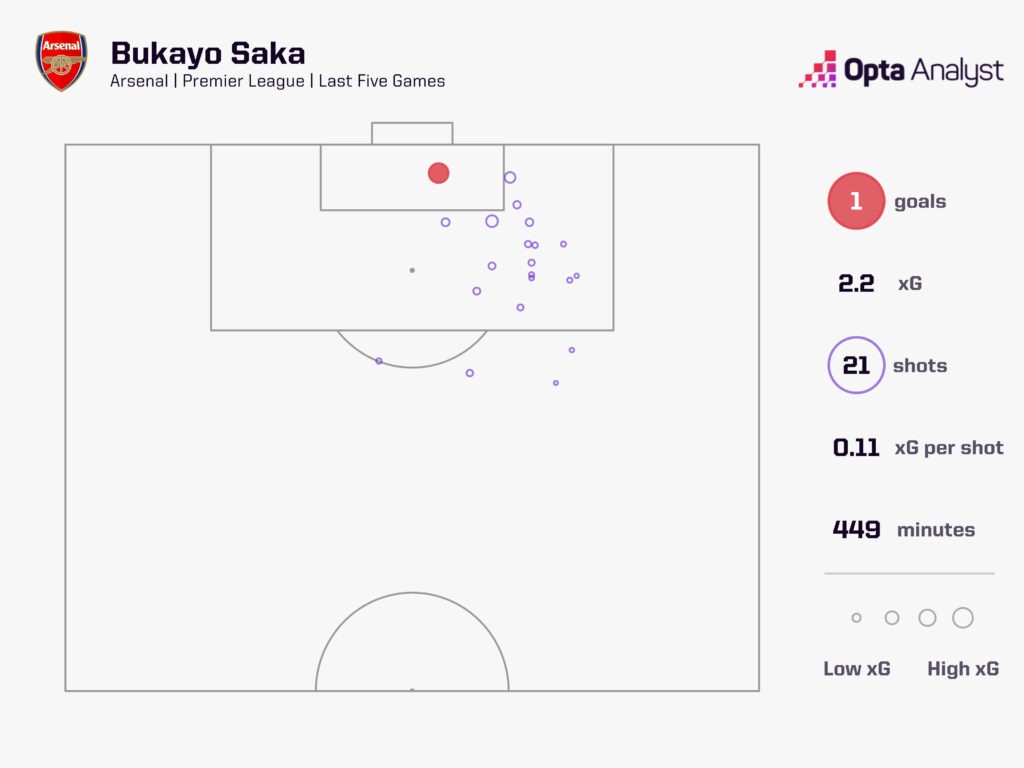
In the busy festive period, Saka played every minute of three games in the space of nine days, from which Arsenal took only one point, drawing with Liverpool before losing to West Ham and Fulham. Only 49 outfielders played as much football as Saka over that time, and just eight of them also, like Saka, play in attack.
In fact, Saka has started every Premier League game this season apart from the win over Manchester City, which he missed through injury. He finishes most games, and the earliest he has been substituted off was in the 73rd minute against Sheffield United. Saka even played 66 minutes of the Champions League demolition of Lens, which Arsenal needed to win to wrap up top spot. But given they were 5-0 up at half-time, it had by the break become a perfect opportunity to give Saka a rest.
Arteta could point to one particular result without Saka as a defence for playing him so much. Saka was rested for most of the EFL Cup trip to West Ham in November, and Arsenal crashed out, losing 3-1.
But Arsenal also beat City without him, and he hasn’t been at his best for a little while now. A rest could do him some good.
There is no doubt that even when Saka isn’t directly contributing to goals, he still does a tonne of important work for the team. Among plenty of things, he helps to relieve pressure on the defence by carrying the ball up the pitch – only 11 players have completed more carries than him (311) this season and only two of those are other attack-minded players in Bernardo Silva (321) and Dejan Kulusevski (315) – with Arsenal always hoping to establish possession in opposition territory. Saka plays a key role in helping that happen.
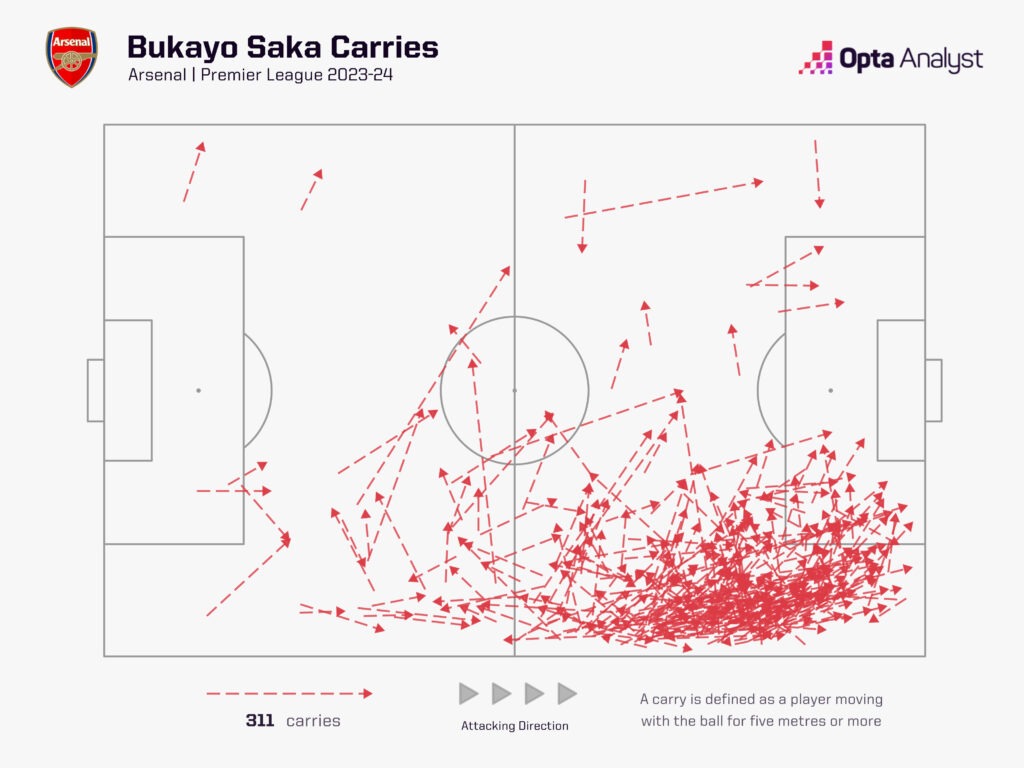
He ranks just outside the top 10 in the Premier League this season for successful dribbles (31) and is the third most-fouled player (43) in the division. Only Manchester United’s Bruno Fernandes (54) and Newcastle’s Kieran Trippier (52) have created more chances than Saka (50), but Saka is top of the entire league for expected assists (6.53), showing that he is creating better quality chances than anyone else in the top flight.
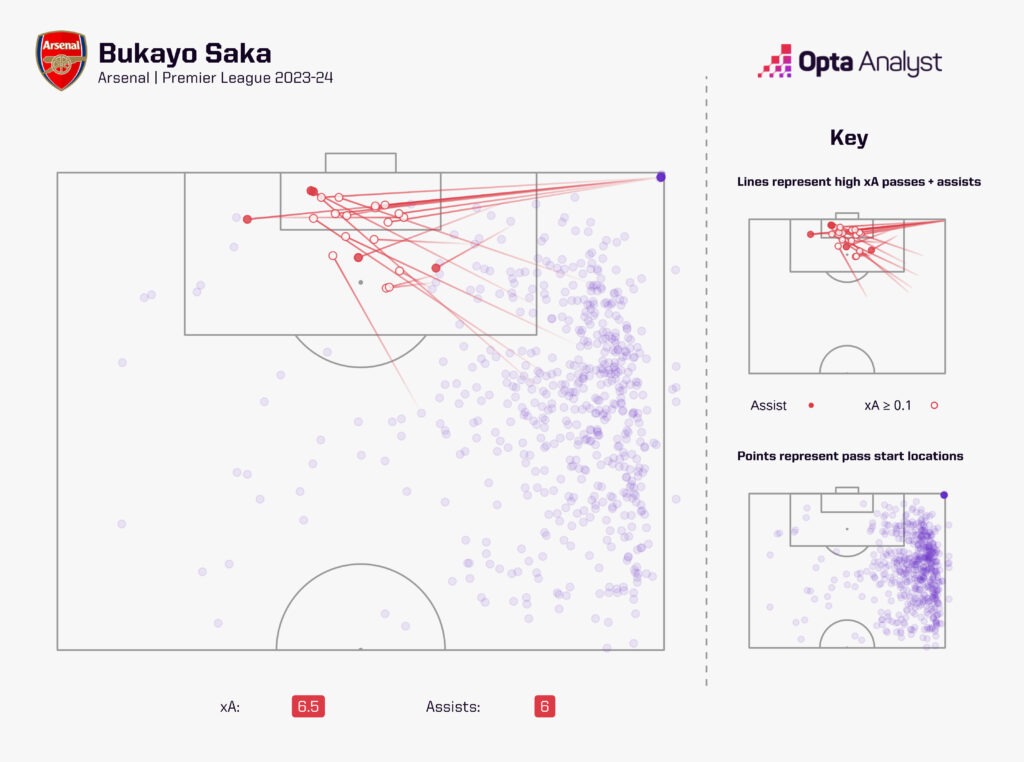
But a decent portion of his telling contributions have come at set-pieces. Arsenal have become the Premier League’s best dead-ball team, with no other side able to better their 11 set-piece goals this season (level with Everton). For comparison, title rivals Liverpool have scored only five.
Set-pieces are very important to Arteta and understandably so given how fruitful they’ve proved, and Saka’s delivery is important to that strategy. But it is also fair to say that we might expect great output from Saka in open play given his ability in attacking positions.
While Saka ranks joint eighth in the Premier League this season for goals and assists (12), he drops down to 20th for open-play goal contributions (7), below Nottingham Forest’s Anthony Elanga (10) and Tottenham much-maligned forward Richarlison (8), and level with Burnley’s Lyle Foster. Saka’s goal at Fulham at the weekend was his first goal or assist in open play since the win over Wolves on 2 December, seven games ago. Saka did well to get into dangerous positions for the goal to put Arsenal ahead and for another chance after Fulham had taken a 2-1 lead, but he skied that later chance high over the bar when most would have expected him to score, or at the very least hit the target. He has looked ever so slightly out of sorts of late, and his team have as a result, too.
Their recent performances may have left Arteta in a quandary. Other managers might consider rotating Saka out and give him a chance from the bench rather than simply hoping he plays his way back into form. The FA Cup tie against Liverpool this weekend could be the perfect opportunity to give Saka a rest that might do him a whole lot of good, particularly with that competition surely not a priority for Arsenal. They have won it four times in the past 10 years, and given they are still in the title race and got a favourable draw in the Champions League round of 16, they should be aiming far higher than another FA Cup triumph.
It is worth noting that shortly after Saka was rested for (most of) the West Ham defeat in the EFL Cup, he went on a run of registering an open-play goal contribution in three successive Premier League games (while also adding two goals and two assists in two Champions League matches). That run of three in three aside, he has four open-play goals or assists in his 16 other Premier League appearances this season.
So, is Arteta just asking too much of his winger? It’s easy to forget that he is still only 22 years old and yet, since the start of 2020-21, Saka’s first full season as a starter for Arsenal – when he had just turned 19 – only 13 players have played more Premier League minutes (including added time) than him (13,394 minutes). Of those 13, Saka is by a distance the youngest, and only three of them are also attackers – players who are generally substituted off more often.
January, with an FA Cup tie next and a winter break that gives Arsenal a 13-day rest before their next match, feels like an ideal time – if ever there was one in this relentless schedule – to give Saka some extended time off.
It might hurt Arsenal in the short term but in the long run, it could benefit them. Getting Saka back to his best surely has to be a priority for Arteta, because doing so could get their title hunt back on track.
The alternate view is that Arsenal need Saka to return to winning ways and the drop-off in quality to their next-best option is too big to allow him a rest. Also, Arteta may look at his team’s underlying numbers from their recent poor run and suggest things haven’t been as bad as four points from a possible 15 suggest.
Over their last five games, Arsenal’s non-penalty expected goals per game has been higher (1.78) than in their first 15 matches of the season (1.57) suggesting they have been creating more. They have gone from an overperformance of 3.71 compared to their xG in their first 15 games to an underperformance of 4.88 in their last five games.
Arteta might reasonably suggest they deserved more from some of those games, and Saka could well have had more open-play goal contributions in that run if he was creating chances for a more natural goalscorer than Gabriel Jesus or Eddie Nketiah, who have eight Premier League goals between them this season. Every other member of the current top six has a single player with more than eight goals on their own, after all.
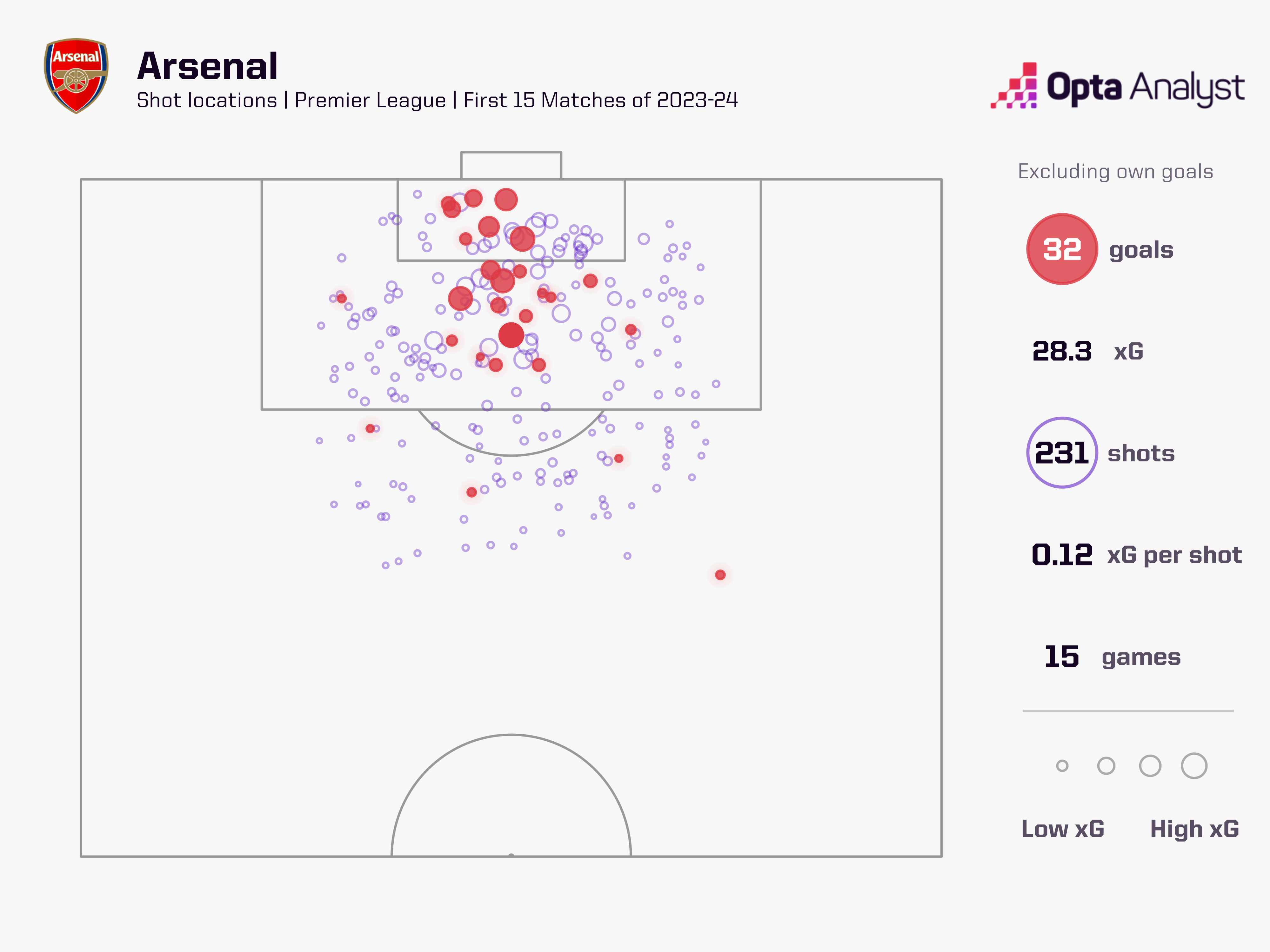
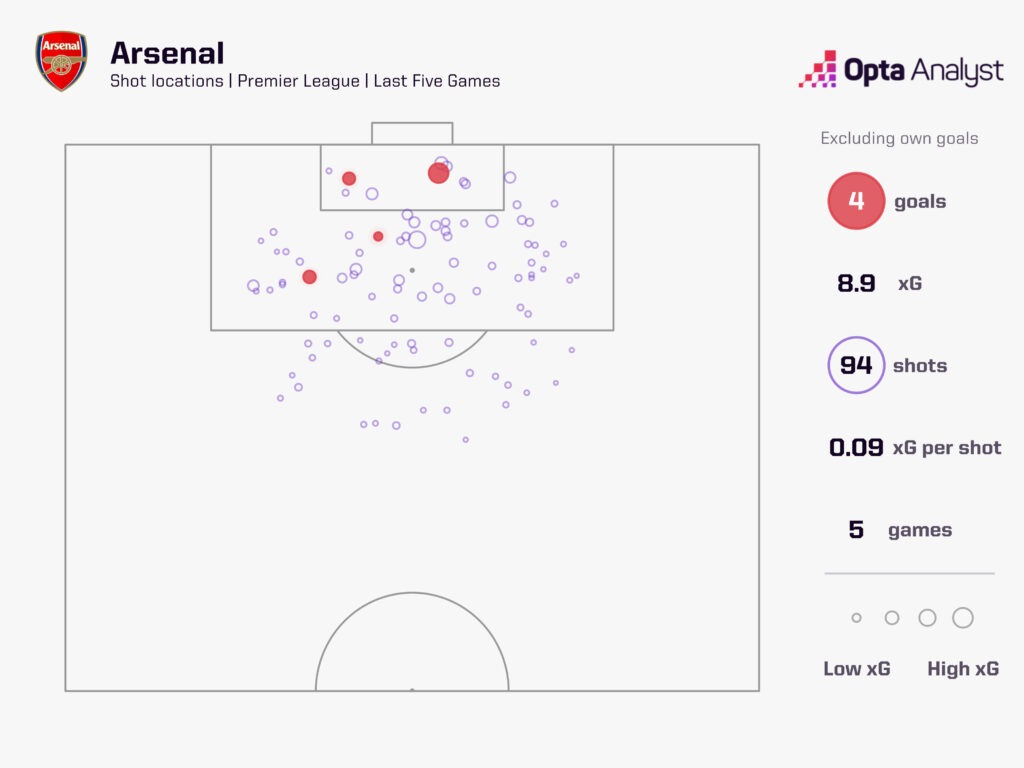
Arteta will say Saka hasn’t been the problem in this recent poor run, and that he is worth sticking with for the important contributions that he continues to make.
We’ll just be left to wonder if a break would help because there is no sign that Arteta will let us see what a properly rested Saka looks like. Quite what that means for Arsenal’s season remains to be seen.
